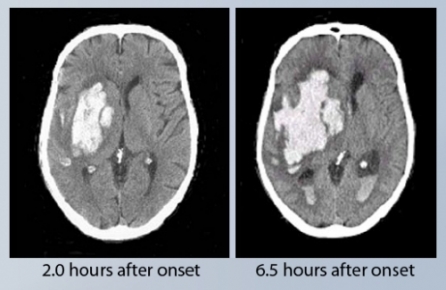You’re the Doctor
By Joseph P. Broderick, MD
Research Director, UCNI
1. The two scans below show the head of the same patient, who suffered an acute stroke (image at left). Members of the Greater Cincinnati/Northern Kentucky Stroke Team reopened a blocked artery in the patient’s brain with t-PA, a clot-busting medicine (right). If the blocked artery can be opened quickly enough, the restoration of blood flow can salvage damaged brain tissue. If reopening occurs too late, brain tissue will die, even if blood flow is restored. In such situations the patient will have a poorer recovery or may die.

Current national guidelines state that t-PA must be administered within how many hours after onset of stroke symptoms?
1) 8 hours
2) 6 hours
3) 4 ½ hours
4) 3 hours
5) 2 hours
(Answer at bottom of page)
2. The two CT images show the head of the same patient, 41⁄2 hours apart. The patient came to the emergency department following a sudden onset of weakness on the left side and become much more poorly responsive during the 41⁄2 hours between scans.

What is the diagnosis?
- Large malignant brain tumor
- Large ischemic stroke (dead brain from not enough blood)
- Large area of encephalitis
- Large brain hemorrhage
Clue: The bone of the skull is the most dense and appears very white on a CT scan; brain tissue is less dense and appears gray; cerebrospinal fluid is the least dense and is dark. One other substance in the body is denser than brain tissue but not as dense as bone.
(Answer at bottom of page)
Change Your Brain, Change Your Life
 Below is a video of Dr. John Tew’s Oct. 6, 2009 presentation, “Change Your Brain, Change Your Life,” to the Tocqueville Society, a leadership arm of United Way of Greater Cincinnati.
Below is a video of Dr. John Tew’s Oct. 6, 2009 presentation, “Change Your Brain, Change Your Life,” to the Tocqueville Society, a leadership arm of United Way of Greater Cincinnati.
*Video:john m. tew, md
You’re the Doctor Answers
1. 4½ hours. And the chance for an excellent outcome dramatically increases the earlier one can administer t-PA after symptoms first start.
2. Large area of encephalitis.


